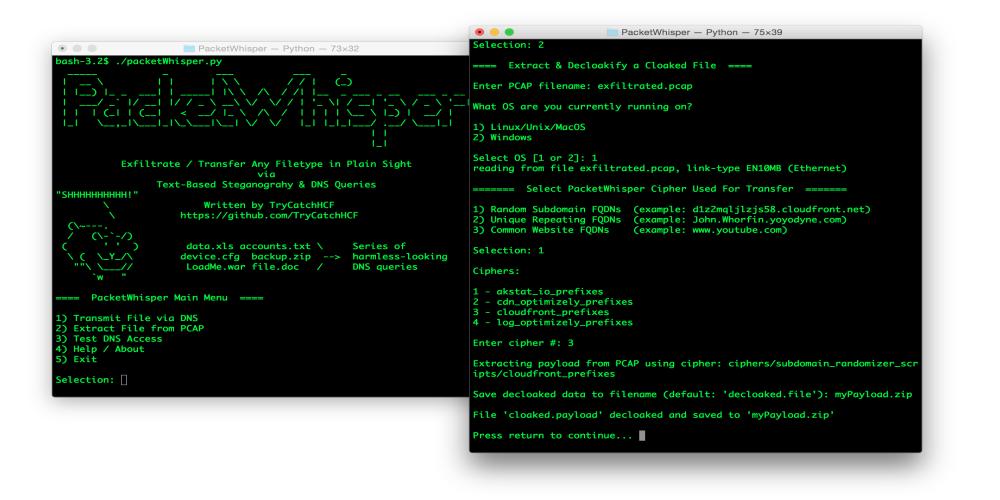PacketWhisper – Stealthily Transfer Data & Defeat Attribution Using DNS Queries & Text-Based Steganography, without the need for attacker-controlled Name Servers or domains
Evade DLP/MLS Devices; Defeat Data- & DNS Name Server Whitelisting Controls. Convert any file type (e.g. executables, Office, Zip, images) into a list of Fully Qualified Domain Names (FQDNs), use DNS queries to transfer data. Simple yet extremely effective.
Traditional DNS exfiltration relies on one of the following: DNS tunneling; Hiding data in DNS query fields; or Encoded / encrypted payloads that are broken up and used as subdomains in the DNS query. All of these methods require that the attacker control a domain and/or an associated DNS Name Server to receive the data, which leads to attribution. Those approaches are also vulnerable to DNS Name Server blacklisting (common) and whitelisting (increasingly common). Another problem is that DFIR analysts are familiar with these methods, and SIEM systems will often detect and alert on seeing them.
PacketWhisper overcomes these limitations.
What if data could be transferred using the target’s own whitelisted DNS servers, without the communicating systems ever directly connecting to each other or to a common endpoint? Even if the network boundary employed data whitelisting to block data exfiltration?
How It Works
To make it all happen, PacketWhisper combines DNS queries with text-based steganography. Leveraging the Cloakify Toolset, it transforms the payload into a list of FQDN strings. PacketWhisper then uses the list of FQDNs to create sequential DNS queries, transferring the payload across (or within) network boundaries, with the data hidden in plain sight, and without the two systems ever directly connecting to a each other or to a common endpoint. The ciphers used by PacketWhisper provide multiple levels of deception to avoid generating alerts as well as to mislead analysis attempts.
To receive the data, you capture the network traffic containing the DNS queries, using whatever method is most convenient for you. (See “Capturing The PCAP File” below for examples of capture points.) You then load the captured PCAP file into PacketWhisper (running on whatever system is convenient), which extracts the payload from the file and Decloakifies it into its original form.
DNS is an attractive protocol to use because, even though it’s a relatively slow means of transferring data, DNS is almost always allowed across network boundaries, even on the most sensitive networks.
Important note: We’re using DNS queries to transfer the data, not successful DNS lookups. PacketWhisper never needs to successfully resolve any of its DNS queries. In fact PacketWhisper doesn’t even look at the DNS responses. This expands our use cases, and underscores the fact that we never need to control a domain we’re querying for, never need to control a DNS Name Server handling DNS requests.
Limitations / Use Notes
Be sure your PCAP file is actually PCAP format. If you used tcpdump or WinDump to capture the file you’ll be fine. Wireshark however offers a wide variety of “Save As…” options for saving Wireshark traffic, only one of which is actually tcpdump/PCAP friendly. I’m working on better error reporting to help catch mistakes early.
Not a secure encryption scheme. PacketWhisper is not a secure encryption scheme. It’s vulnerable to frequency analysis attacks. Use the ‘Unique Random Subdomain FQDNs’ category of ciphers to add entropy and help degrade frequency analysis attacks. If payload secrecy is required, be sure to encrypt the payload before using PacketWhisper to process it.
Not a high-bandwidth transfer method. PacketWhisper relies on DNS queries, which are UDP-based, meaning order of delivery (or even successful delivery) of the request is not guaranteed. PacketWhisper by default adds a small (1/2-second) delay between each DNS query. You can safely transfer payloads at a rate of about 7.2K per hour (120 bytes per minute). That’s based on the size of the original payload, not the Cloakified output file. You can opt for no delay between between queries, which dramatically speeds up the transfer but at the risk of increased network noise and corrupted payload.
And let’s face it, if you have non-DNS modes of data transfer available, you can just use the main Cloakify Toolset project to hide the file in plain sight (maybe turn the payload into a list of PokemonGo monsters w/ LatLon coordinates) and use all that high bandwidth available via FTP/HTTP/etc. DNS is extremely useful when other protocols are blocked, but always be aware of your options.
DNS is DNS. Different OS’s have different DNS caching policies, etc. Networks may be down, isolated, etc. PacketWhisper includes a quick manual check to see if it can resolve common FQDNs, but DNS is often a messy business. Remember the old IT troubleshooting mantra: “It’s always DNS.”
Requires
- Python 2.7.x (3.6.x port is underway)
- For decoding payloads: tcpdump (included on Linux & MacOS) or WinDump (Windows)









